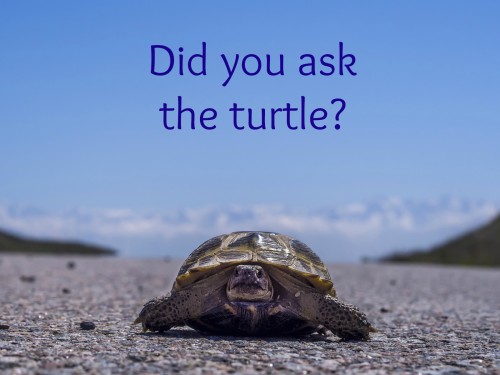Did you ask the turtle?

“Did you ask the turtle?”
That’s a question Gloria Steinham was asked in college after helping a turtle to the other side of the road.
It’s a cautionary tale about wanting to help people who don’t need our help.
That can be a hard lesson to learn.
Gloria Steinem, writer and leader of the women’s rights movement, gave a talk to Smith College alumni about lessons from her education, about how seemingly small incidents can have very big impacts.
At Smith, needing to fulfill her science course requirements, Ms. Steinem admitted she took a geology course because she considered it the least scientific of all the sciences.
While on a field trip in the wetlands of New England’s Connecticut River, she saw a giant turtle which had climbed out of the river, crossed a road and was in the mud of an embankment of another road, seemingly about to crawl up and get squashed by a car.
Gloria, fearing the turtle was going to cross the road and get run over, picked it up and carried it to the other side.
Her professor saw this and said, “Did you ask the turtle before you moved it? That turtle probably spent a week crawling up that dirt road to lay its eggs in the mud by the side of the road, and you just put it back in the river.”
So the lesson was, “Always ask the turtle.”
Or put another way, always ask those you want to help what it is they actually need and want.
This turtle story was told to me by a Smith College graduate who attended Ms. Steinem’s lecture. My friend had just organized a dinner party for someone who was visiting her only to find out that friend didn’t want a dinner party in her honor.
Live and learn.
Because you never asked
In his popular TED talk, Ernesto Sirolli tells the story of a group of Italians going to Zambia in the 1970s with seeds to teach the Zambian people how to grow Italian tomatoes and zucchini in their magnificent rich soil.
The Italians couldn’t understand why the Zambians didn’t have any agriculture in such a fertile area. Yet the Zambians showed no interest in learning how to farm.
Sirolli thought, “Thank God we’re here. Just in time to save the Zambian people from starvation.”
The tomatoes grew beautifully in that valley and, just when they were ripe and red, overnight, some 200 hippos came out from the river and ate everything!
And the Zambians pointed out, “That’s why we have no agriculture here.”
“Why didn’t you tell us?
“You never asked.”
What not to donate after a disaster
One of my favorite films is “Starman,” in which Jeff Bridges played an alien visiting earth. Just before he returned home, he said, “What I admire most about earth people is that, when things are at their worst, you are at your best.”
Nowhere is this truer than when there has been a natural disaster and we want to do something to help.
From the goodness of our hearts, we all feel compelled to take action when we learn of earthquakes, tsunamis, fires and floods. Gathering items to ship is literally taking action, and somehow seems more fulfilling than sending money.
Food and clothing drives make the givers feel good but are seldom what’s needed and may actually get in the way and hinder professional disaster efforts.
Many of these good-hearted donations sent to the disaster sites are what professional relief workers call the “disaster after the disaster.”
For example, used clothing would first have to be sorted and cleaned and relief workers don’t have time to do that.
When truck drivers after Hurricane Andrew couldn’t find organizations or warehouses to take the clothes, they left them on the side of the road where they rotted in rainstorms and summer heat and blocked the roads.
A better idea would be for the original senders to sell the clothes at a yard sale and send the proceeds to disaster relief organizations.
One estimate is that 60% of the donations to a disaster site are not needed. And unloading and storing or disposing of unnecessary donations can take away from more important relief efforts.
In most cases, the best donation is cash. Let the professional rescue organizations use it to bring in the supplies they know are needed, in an organized manner.
So that’s a great lesson that turtle brings us. She might have wanted to stay in the road or turn around – whatever.
That was her choice.
So always ask the turtle before you step in. Everyone may be the better for it.
Molly Larkin is the co-author of the international best-seller “The Wind Is My Mother; The Life and Teachings of a Native American Shaman” and other books on health. She is passionate about helping people live life to their fullest potential through her classes, healing practice and blog at www.MollyLarkin.com

